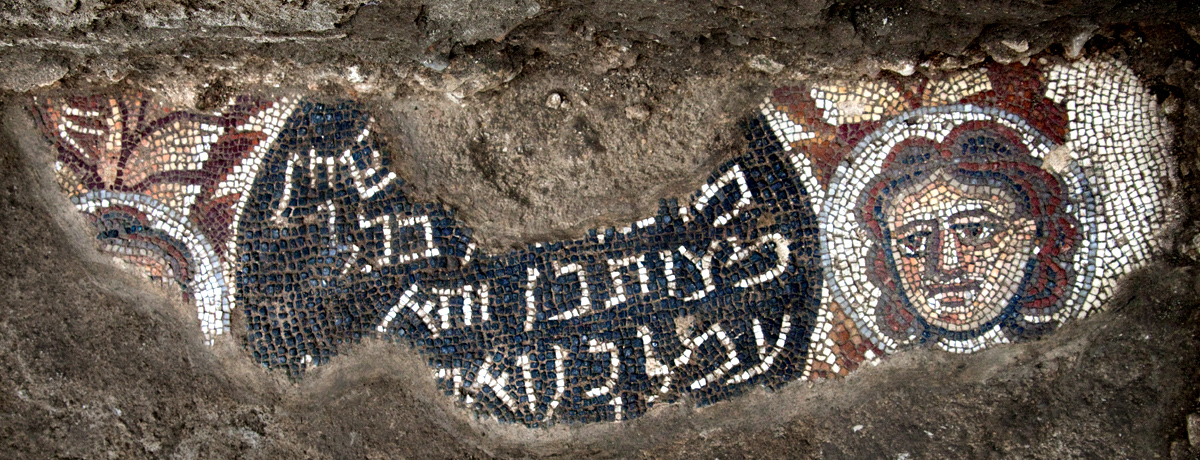A research team from the University of North Carolina-Chapel Hill led by Professor Jodi Magness uncovered a spectacular mosaic panel during excavations at the 1,600-year-old synagogue at Huqoq, an ancient Jewish village in Israel’s Lower Galilee located 12.5 km north of Tiberias and uphill from Capernaum and Magdala. The panel was located at the main entrance of the synagogue, which is believed to be from the late Roman period (400 CE).
The mosaic panel features a Hebrew inscription framed within a wreath. To the sides and below the wreath, an Aramaic inscription lists the names either of the donors who provided funding for the synagogue’s mosaics or the artists who made them, asking that they be remembered for good. The wreath is flanked on either side by lions resting their forepaws on bulls’ heads. The entire panel is surrounded by a decorated border showing animals of prey pursuing other animals.
The panel was uncovered in this, the eleventh and final season of the excavation carried out under the direction of Magness, the Kenan Distinguished Professor of religious studies in Carolina’s College of Arts and Sciences, along with Assistant Director Dennis Mizzi of the University of Malta.
This season was also focused on exposing the mosaic panels that were uncovered in 2012 and 2013. These panels depict the episodes of Samson and the foxes, as mentioned in Judges 15:4, and Samson carrying the gate of Gaza on his shoulders, referenced in Judges 16:3. During a battle with the Philistines, Samson catches 300 wild foxes, ties burning torches to their tails and sets them loose to set fire to Philistine grain fields. Newly exposed sections included a Philistine horseman and a slain Philistine soldier with a striking, classic face.
Excavations in 2022 uncovered a panel in the southwest aisle divided into three horizontal strips that depict an episode from Judges chapter 4: the biblical prophetess and judge Deborah under a palm tree, gazing at Barak, who is equipped with a shield; and the Kenite woman Jael (Yael) hammering a tent stake through the temple of the Canaanite general Sisera, who lies dead on the ground with blood gushing out of his head. These are the earliest known depictions of the biblical heroines Deborah and Jael.
The 2022-2023 excavations also exposed an enormous paved courtyard surrounded by a row of columns known as a colonnade to the east of the synagogue. In the late medieval period, the courtyard was repurposed and a massive, vaulted structure of unknown function was built on top of it.
“The ancient village is surrounded by associated features, including cist graves, rock-cut tombs, a mausoleum, quarries, agricultural terraces and installations, a winepress, and an olive press,” Magness wrote in her preliminary report. “Two large miqwa’ot (ritual baths) are hewn into the bedrock on the eastern and southern periphery of the ancient village (see below).”
Among the structures uncovered during the 2012 dig were the remains of the elaborate synagogue. Findings include limestone carvings and an elaborate floor mosaic. The synagogue’s walls and columns were painted in bright colors: plaster fragments show traces of pink, red, orange, and white pigments. The artistry of the mosaic, which is composed of tiny tiles, together with the large stones used for the walls, attests to the prosperity of the village.
“There’s actually plenty more that could be excavated. it’s an amazing site,” Magness said. “Huqoq in particular; nobody really had ever paid attention to the site previously and it turns out it’s an incredible site with a very rich history.”
The archaeological project at Huqoq has uncovered numerous significant finds, including many that are based on the Bible:
- A Hebrew inscription surrounded by human figures, animals, and mythological creatures, including putti, or cupids.
- The first non-biblical story ever found decorating an ancient synagogue — perhaps the legendary meeting between Alexander the Great and the Jewish high priest.
- A panel depicting two of the spies sent by Moses to explore Canaan carrying a pole with a cluster of grapes, labeled “a pole between two” from Numbers 13:23.
- Another panel shows a man leading an animal on a rope accompanied by the inscription, “A small child shall lead them” (Isaiah 11:6).
- Figures of animals identified by an Aramaic inscription as the four beasts representing four kingdoms in the book of Daniel, chapter 7.
- A large panel in the northwest aisle depicting Elim, the spot where the Israelites camped by 12 springs and 70 date palms after departing Egypt and wandering in the wilderness without water, referenced in Exodus 15:27.
- A portrayal of Noah’s Ark.
- The parting of the Red Sea.
- A Helios-zodiac cycle.
- Jonah being swallowed by three successive fish.
- The building of the Tower of Babel.
The city was mentioned in the Book of Joshua:
The boundary then turned westward to Aznoth-tabor and ran from there to Huqoq. It touched Zevulun on the south, and it touched Asher on the west, and Yehuda at the Yarden on the east. Joshua 19:34
During the Roman period, the city was known as Hucuca. The Roman period village was large and prosperous due to the presence of a constant spring. It is apparent from both the synagogue and the absence of pig bones that the Roman period village was Jewish.
Researchers discovered that the synagogue was rebuilt and expanded in size in the early 14th century C.E. (the late medieval/Mamluk period) when a new international highway connecting Cairo and Damascus was built next to the city. At the time, the city was called Yakuk. There was a tradition that the Tomb of Habakkuk was nearby, and the city became the focal point of late medieval Jewish pilgrimage.
With the conclusion of this final season of excavations, the excavated area will be turned over to the Israel Antiquities Authority and the Keren Kayemet Le’Israel (Jewish National Fund), which plans to develop the site as a tourist attraction.



